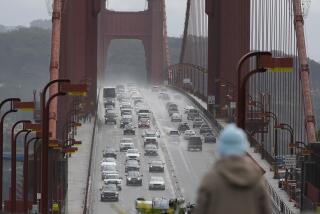Legislating Safer Car Rides for Future Babies
- Share via
WASHINGTON — Car seats for kids would be a snap to install under a safety rule the Clinton administration is expected to announce soon, but experts say it will take a generation for a majority of American children to benefit.
The rule, which has received final White House approval, would require auto makers to build standard child-seat anchors into the back seats of new cars, eliminating a hodgepodge of belts and clips that now results in a slippery fit for nearly nine of 10 child seats. New seats would be designed to connect to metal anchors.
But since the rule applies only to new cars, parents driving older cars would not benefit for years. According to the market survey firm of J.D. Power & Associates, young families are more likely to drive used cars. Experts say it could take an estimated 10 to 20 years before a majority of cars on the road have the new anchors.
“As far as an immediate solution that’s going to save your kids and mine, it probably won’t affect the current toddlers,” said Joe Colella, a Maryland safety advocate whose 3-year-old niece was killed in an incorrectly fitted child seat. “It will save a lot of lives in the long run.”
To help parents with older cars, the National Transportation Safety Board has called for a nationwide network of local centers staffed by trained advisors who could check if child seats are safely installed.
The rise of working mothers, day care and single-parent families means that today’s young children spend more time in cars than did the baby boomers in their infancy.
“Children have a very complicated transportation life,” said Stephanie Tombrello, director of SafetyBeltSafe U.S.A., a Torrance-based information clearinghouse for parents. “There are lot more children on the road, and not only are they riding in their parents’ cars, but in caregivers’ cars as well, and using different car seats.”
Car crashes are the leading cause of death among children ages 1 to 4. But statistics suggest that many parents are complacent about using car seats for their children. A SafetyBeltSafe U.S.A. survey of 754 Southern California adults, who were ticketed for not putting kids in a child seat, found that 95% owned one but weren’t using it.
And according to a General Motors analysis of national statistics, of the 604 children age 4 and under who died in crashes in 1997, 45% were neither in child seats nor belted. Of the 1,424 children ages 5 through 15 who were killed, the proportion unbuckled was even higher--63%.
80% of Child Seats Not Properly Fitted
A properly installed child seat should barely budge. Experts say it shouldn’t give more than an inch from side to side, front to back. But volunteers who run safety clinics for parents routinely find that at least 80% of seats are not fitted correctly.
For Lilly Barrett of Simi Valley, finding a child seat for her infant daughter, Talia, proved a challenge. Barrett, 35, a photo-illustrator of children’s books, and her husband, an emergency medical technician, had bought a used Volvo with safety in mind. Next, she researched child seats and purchased a state-of-the-art model.
“We could not install it,” Barrett said. “It would fishtail in the car.” She exchanged the seat for a less elaborate model that fit. “It’s a do-it-yourself world out there,” she said.
The Clinton administration is advocating a simpler approach.
There are now 100,000 potential combinations of child seats and car models, according to Transportation Safety Board Chairman Jim Hall. Safety advocates say the new rule would reduce that to two.
One type would hook to the new anchors in the back seat of a car by means of clips at the end of two adjustable belts attached to the sides of the seat.
The second type, more expensive, would snap on to the anchors by means of two rigid metal attachment bars at the base of the child seat. In tests, this type has been shown to fit more securely.
Both types of child seats would come with a top tether, for added security.
Some Cars Will Have New System Next Year
The system will be phased in within five years, but many auto and child-seat makers will offer it sooner, because of its appeal to parents. Some model year 2000 cars available in the fall may be equipped with the new anchors. It’s expected to add about $10 per installation to the cost of a car, and $10 to $65 to the cost of a car seat.
A formal announcement of the rule may come during Child Passenger Safety Week, which begins Feb. 14.
Simpler child seats are a “brilliant” idea, said Barrett, the new mother from Simi Valley. But she’s disappointed that only new-car buyers will benefit. “We wouldn’t be able to afford a new car,” she said.
GM safety engineer Artie Martin said it makes little sense to neglect parents who are driving older cars. “The availability for these parents to check if their kids’ seats are properly installed needs to be there,” she said.
Safety advocates also see an urgent need for stronger enforcement of seat-belt laws. Federal officials consider California strict on enforcement, but many states defer to parental judgment.
“We need enforcement before the child is dead,” said Annemarie Shelness, a longtime auto-safety advocate from Winston-Salem, N.C. “It has to get around that you are going to get a fine if you don’t have your child correctly restrained.”
More to Read
Sign up for Essential California
The most important California stories and recommendations in your inbox every morning.
You may occasionally receive promotional content from the Los Angeles Times.













